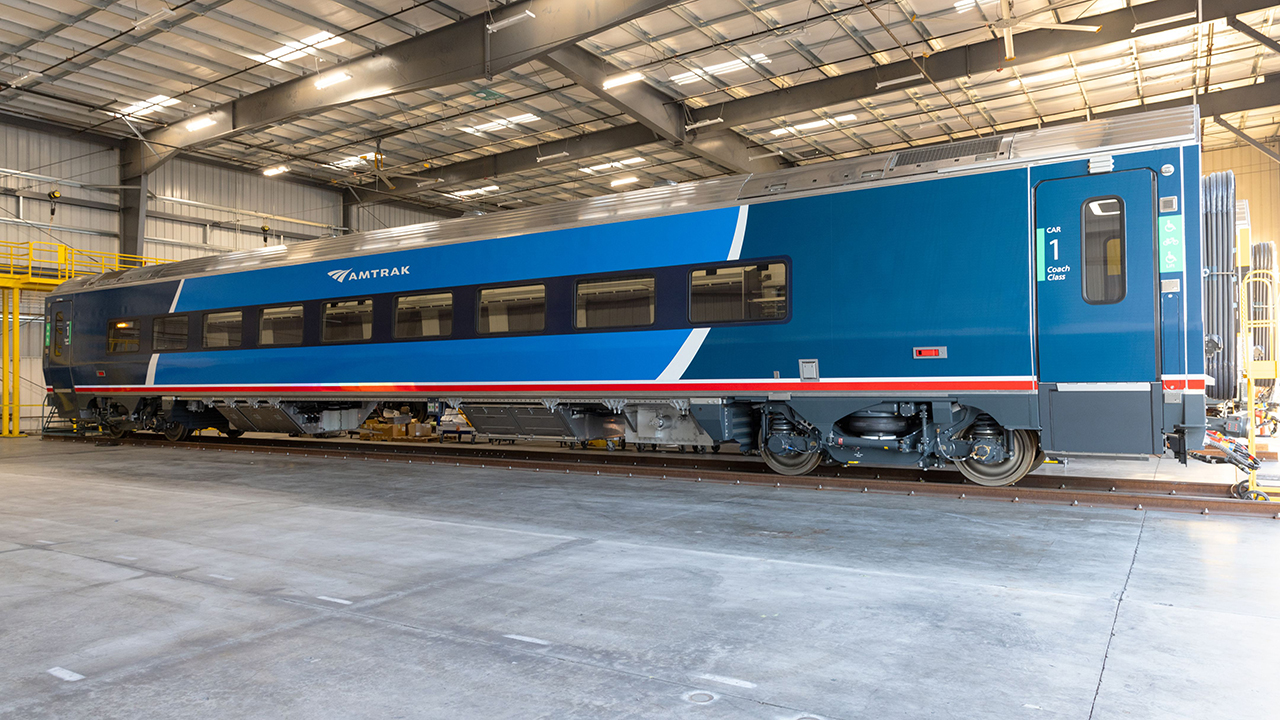
Amtrak L-D Fleet: Five Possible Contingencies
Written by Jim Tilley, President, Florida Coalition of Rail Passengers
Among the options is repurposing for long-distance service some of the Airo cars that Siemens is currently building for short-distance routes.
Editor‘s note: Jim Tilley recently wrote to Amtrak Board Chair Anthony Coscia regarding procurement of a new long-distance fleet. We reproduce this letter in its entirety and will likewise publish a response from Coscia, should he choose to respond. – William C. Vantuono
Dear Mr. Coscia:
I address this letter to you because, in your continuing role as a member of the Amtrak Board, you are best positioned to respond. I am the President of the Florida Coalition of Rail Passengers and Co-chair of The Aurora Group. Both organizations advocate on behalf of America’s travelers and rail passengers. I am a professional railroader. I have held the inter-disciplinary positions of Vice President-Car Management at Genesee & Wyoming, Vice President-Sales & Marketing at Bombardier Capital Rail, and Assistant Treasurer at CSX Transportation responsible for the financing of much of the CSX fleet.
Our question: How does Amtrak expect to maintain its long-distance services into the future? In the past six years, Amtrak has allowed its long-distance fleet to shrink even though it will be years before Amtrak can obtain new equipment. Does Amtrak have a plan to bridge the period between today and the time new equipment arrives? If one exists, we urge the Board to make that plan publicly available. All your stakeholders—including Congress, taxpayers and your passengers—deserve to know what it is. If one does not exist, the Amtrak Board should require one, quickly.
The situation: In October 2018, Amtrak had 713 active cars in its long-distance fleet. By October 2023 the number dropped to 658 cars, a 7.7% decrease. By contrast, during the same period, the Inactive fleet grew from 33 to 107 cars, a 224% increase. This ongoing erosion of the long-distance fleet has already forced Amtrak to reduce capacity on its long-distance trains. Without immediate corrective action, the equipment shortage will only grow, likely forcing Amtrak, in the not-too-distant future, to eliminate daily service or to eliminate entire routes. Or both. The cosmetic “refresh” being done on this equipment is wholly inadequate to ensure its longevity.
Lead times are probably longer than expected: The RFP for new long-distance equipment that Amtrak issued in December 2023 is so complex that the railcar manufacturers have already requested an extension beyond the mid-May “close date.” It suggests that Amtrak’s goal is to re-invent the entire concept of long-distance passenger trains without balancing the longer lead time required against the immediate need for new equipment at reasonable cost. It specifies not only a large number of different car types but also outlines, in great specificity, requirements for such details as window coverings and luggage racks. To illustrate, Appendix D, Mechanical Department Specification is 1,379 pages; Exhibit F-1, Product Feature Sheets, is 461 pages; Exhibit F, The Customer Experience Vision Part 2, exceeds 150 pages.
Past experience: The Avelia Liberty (Acela II) procurement from Alstom, the Midwest Venture car procurement from Siemens and the Viewliner procurement from CAF says Amtrak should anticipate this procurement also taking far longer than expected. Prudent management should have contingency plans that ensure continued operation of the long-distance network if such delays materialize. Does Amtrak have any?
Contingency Options
The first and likely fastest and most economical option would be to remanufacture the existing fleet. Chief Executive Officer Stephen Gardner says the lack of replacement parts precludes this possibility. Recent history at our Canadian neighbor, however, suggests otherwise. VIA Rail Canada has remanufactured railcars (some discarded by Amtrak) that were built in the 1950s and remain in service today. The privately operated Rocky Mountaineer is competing with Amtrak west of Denver utilizing Canadian railcars built in the 1960s and remanufactured to extend their service lives. With this experience in mind, Mr. Gardner must acknowledge that remanufacturing existing cars would update many, if not most, of their life expired components. This approach would even make carbodies that have been stripped of parts to repair other cars eligible for remanufacture. By utilizing Beech Grove as a remanufacturing hub, Amtrak would satisfy Buy America requirements. Amtrak’s labor agreements also permit outsourcing, so some overhauls and brake tests could be performed at other Amtrak locations or by other shops. Alstom (which is constructing the 28 Avelia Liberty trainsets for the Northeast Corridor), for example, has remanufactured bilevels at Mare Island, Calif.
A second option would be to utilize the Viewliner shell (for which Amtrak owns the rights) as a platform for updated designs of long-distance single-level sleepers, coaches, lounge and dining cars.
A third option would be to repurpose for long-distance service some of the Airo cars that Siemens is currently building for short-distance routes.
A fourth option would be to issue a supplemental—and less prescriptive—RFP that would incentivize suppliers to offer less-customized, more off-the-shelf designs that they could deliver quickly and at lower cost.
A fifth option would be to procure equipment from overseas. VIA Rail Canada sourced long-distance equipment from Europe 20 years ago, modifying it to comply with North American railcar standards. Amtrak similarly purchased and deployed trainsets from France. Amtrak also imported various high-speed trains from Europe for demonstration service in the Northeast. If necessary, Amtrak could seek emergency waivers from specific provisions of the Buy America or Americans with Disabilities acts.
Amtrak first identified the need for new long-distance equipment in its 2010 Fleet Plan. Yet, 14 years later, the procurement still isn’t off the drawing board. Time is no longer on our side. Corrective action today is necessary to prevent collapse of National Network service tomorrow. We hope that the information and ideas we have offered will benefit America’s Railroad as its leadership works to serve the mobility needs of the traveling public throughout all of America. We look forward to your response.



